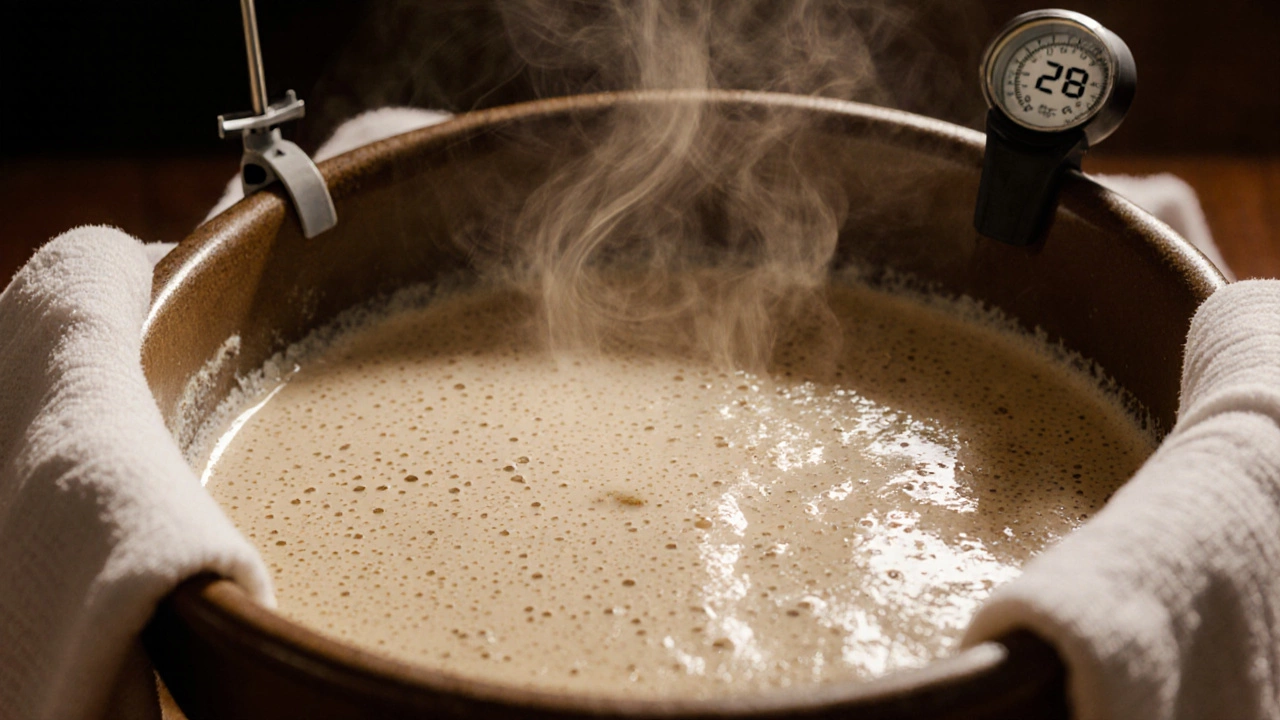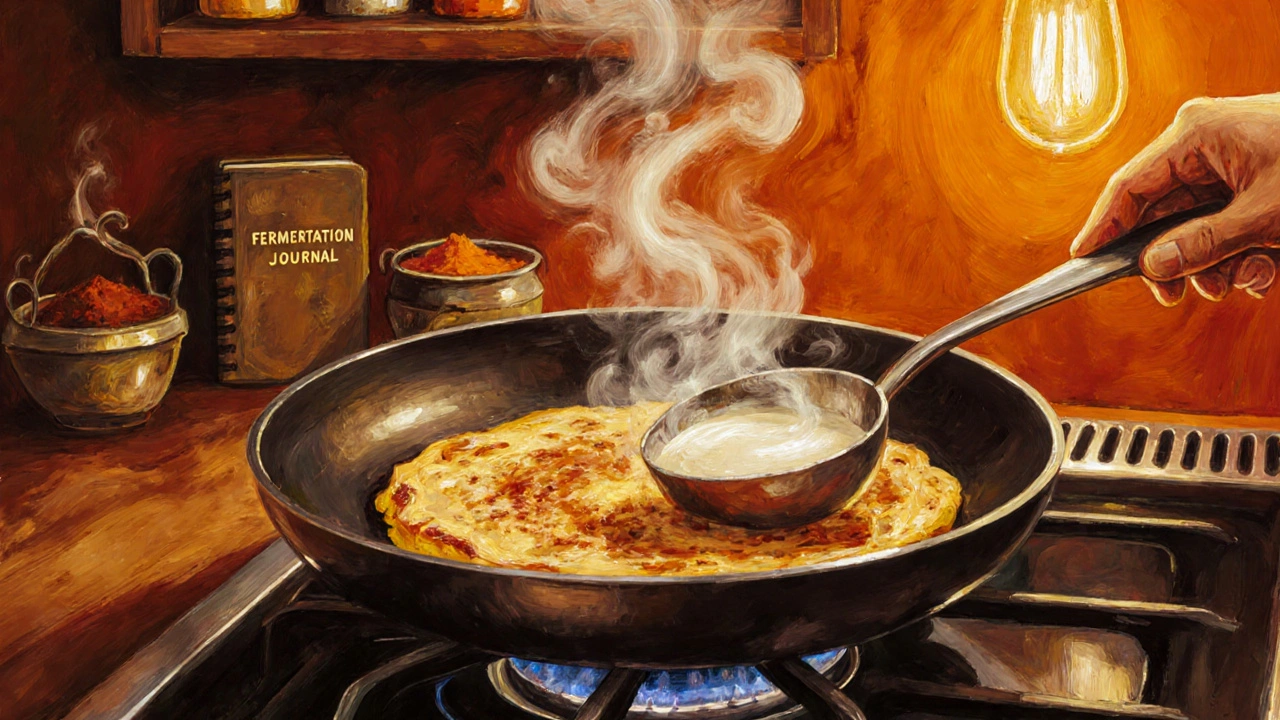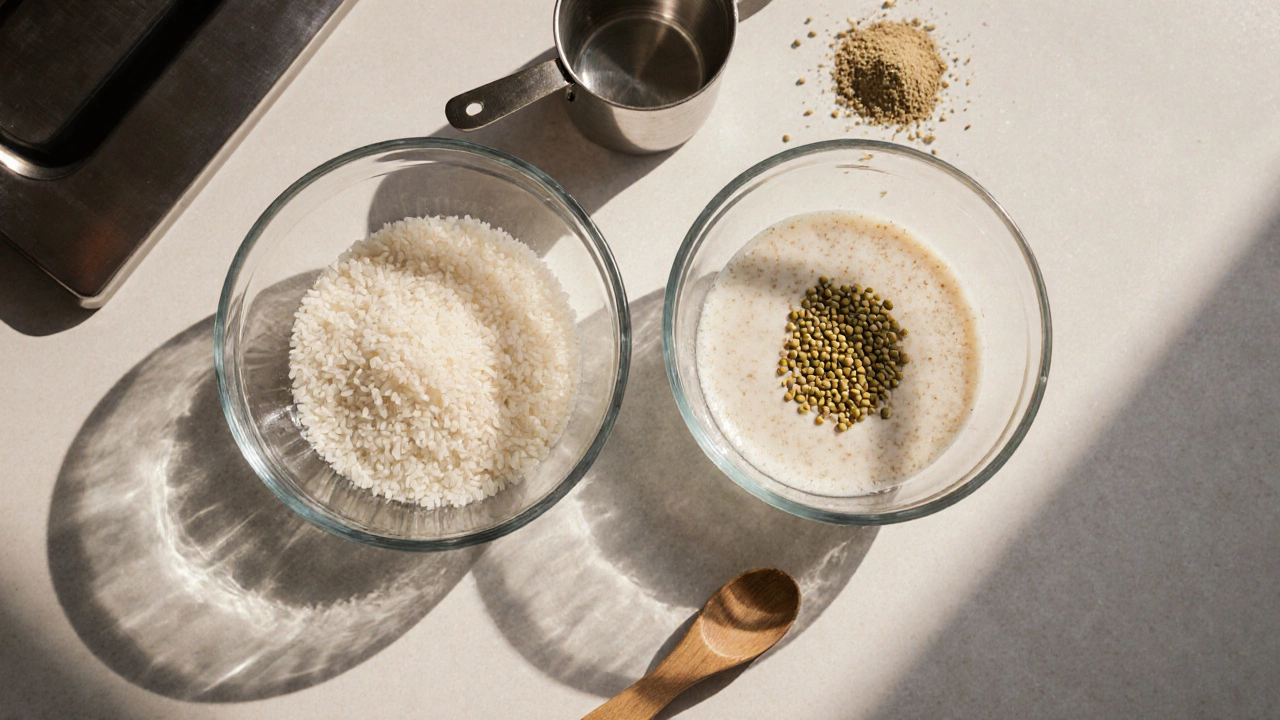Dosa Batter Fermentation Time Calculator
Fermentation Time Calculator
How It Works
Fermentation time depends on temperature. Use this calculator to find your optimal time based on your kitchen conditions:
Getting the right Dosa batter is a science and an art. The key step? dosa batter fermentation. If you’ve ever wondered whether 6, 8, or 12 hours is the sweet spot, you’re not alone. Below we break down the factors that control fermentation, give you a practical timeline, and share tips to avoid common pitfalls.
What Exactly Is Fermentation?
Fermentation is the natural process where microbes - mainly lactic‑acid bacteria and wild yeasts - turn the starches in rice and the proteins in urad dal into a tangy, airy batter. In a Fermentation environment, sugars are broken down, carbon dioxide is released, and the batter gets that characteristic sour smell.
Why Time and Temperature Matter
Two variables dominate the clock: how long you let the batter sit and how warm the room is. Micro‑organisms thrive between 25 °C and 35 °C (77 °F‑95 °F). Below 20 °C (68 °F) they crawl, and above 38 °C (100 °F) they can die off, giving you a flat, un‑fermented mix.
- Short ferment (4‑6 hrs) at 30 °C: Slight tang, batter stays thin, good for quick weekday meals.
- Standard ferment (8‑10 hrs) at 28‑30 °C: Balanced sourness, airy texture, perfect for classic dosa.
- Long ferment (12‑16 hrs) at 25‑27 °C: Deep sour note, larger bubbles, ideal for fluffy idli or very crisp dosa.
Adjust the time if your kitchen is cooler or warmer than the ranges above.
Step‑by‑Step Timeline for a Typical Home Kitchen
- Soak the grains: Rinse 2 cups of raw rice and ½ cup of whole urad dal. Soak rice for 4 hrs, dal for 6 hrs. Adding a pinch of fenugreek seeds to the dal helps boost foam.
- Grind: Drain and blend the dal with a little water to a smooth paste. Then blend the rice (and any leftover water) into a slightly coarse batter. Mix both together.
- Season: Add 1 tsp salt and ½ tsp fenugreek powder. Stir well.
- Set the temperature: If it’s colder than 22 °C (72 °F), place the bowl in a warm spot - an oven with the light on, a sunlit windowsill, or a insulated box with a heating pad set to low.
- Wait: Let the batter sit undisturbed. Check after 4 hrs; you should see small bubbles forming. At the 8‑hour mark, the batter should have doubled in volume and smell mildly sour.
- Test the consistency: Stir the batter; it should be pourable, similar to a thin pancake batter. If it’s too thick, add a splash of water. If too thin, add a spoonful of rice flour.
- Cook: Heat a non‑stick or cast‑iron skillet, drizzle a few drops of oil, pour a ladle of batter, spread thin, and wait for bubbles to pop before flipping.
Following this routine usually lands you at the 8‑10 hour window for a classic, crispy‑yet‑soft dosa.

How Different Temperatures Shift the Clock
| Ambient Temperature (°C) | Typical Fermentation Time | Resulting Flavor |
|---|---|---|
| 20‑22 | 12‑16 hrs | Deep sour, very airy |
| 25‑27 | 8‑10 hrs | Balanced tang, good bubbles |
| 30‑32 | 4‑6 hrs | Light sour, slightly denser |
| 35+ | 2‑3 hrs (risk of over‑acidic) | Very sharp, may collapse |
Use the table as a quick reference. If you’re in Wellington, where the climate can swing between 12 °C (54 °F) in early spring and 22 °C (72 °F) in summer, you’ll often need to lengthen the ferment in cooler months.
Common Mistakes and How to Fix Them
- Forgot the fenugreek: Without the natural enzymes in fenugreek, the batter can stay flat. Add ½ tsp powdered fenugreek if you missed it during grinding.
- Using hard water: High mineral content can inhibit bacterial growth. If your tap water is hard, switch to filtered or bottled water for soaking and grinding.
- Covering the bowl too tightly: Trapped carbon dioxide can create an anaerobic environment and produce off‑flavors. Use a loose lid or a clean kitchen towel.
- Storing batter in the fridge too early: Cold slows fermentation dramatically. Let the batter reach its peak at room temperature, then refrigerate to prolong shelf life (up to 3 days).
- Over‑fermenting: After 18‑20 hrs at low temperature, the batter turns overly sour and loses elasticity. Discard if the smell is vinegar‑like.
Pro Tips for Perfect Dosa Every Time
- Keep a fermentation journal: Note the date, start time, ambient temperature, and tasting notes. You’ll spot patterns quickly.
- Use a starter culture: Some home cooks keep a small portion of well‑fermented batter as a starter. Adding a spoonful speeds up the process and stabilizes flavor.
- Pre‑heat the skillet: A hot pan triggers the rapid rise of bubbles, giving you that signature crisp edge.
- Don’t rush the grind: A smoother dal paste produces finer bubbles. Use a wet grinder if possible; a high‑speed blender works but may add too much heat.
- Experiment with rice types: Traditional idli rice works well, but you can mix in a bit of parboiled rice for extra crunch.

What If You Miss the Ideal Window?
Life gets busy - sometimes the batter sits longer than planned. Here’s how to rescue it:
- Blend in a little fresh rice‑dal mixture: This dilutes excess acidity and re‑introduces starch for better texture.
- Add a pinch of baking soda: It neutralizes excess sourness and creates bigger bubbles during cooking.
- Make pancakes instead of dosas: Over‑fermented batter works great as a tangy pancake or even a savory crepe.
FAQ - Your Quick Answers
How long should dosa batter ferment at room temperature?
At 28‑30 °C (82‑86 °F) the batter typically needs 8‑10 hours to reach the right sourness and bubble formation.
Can I ferment dosa batter in the refrigerator?
Yes, but the process slows dramatically. Use the fridge only after the batter has finished its room‑temperature ferment; it will keep for 2‑3 days.
What temperature is ideal for fermenting dosa batter?
Between 25 °C and 35 °C (77‑95 °F). Below 20 °C the batter ferments very slowly, and above 38 °C the microbes may die.
Why does my dosa batter turn flat after fermenting?
A flat batter usually means the temperature was too low, the fermentation time was too short, or the lid was sealed tightly, preventing gas buildup.
Is it safe to eat over‑fermented dosa batter?
If the batter smells like vinegar and has a sourness beyond pleasant, it’s best to discard. Over‑fermented batter can harbor unwanted microbes.
Wrapping It Up
In most homes, aiming for 8‑10 hours at a steady 28‑30 °C gives you that classic dosa flavor and texture. Adjust the clock when the weather changes, keep an eye on bubble formation, and use the tips above to troubleshoot. With a little practice, you’ll know exactly how many hours your batter needs, no guesswork involved.
